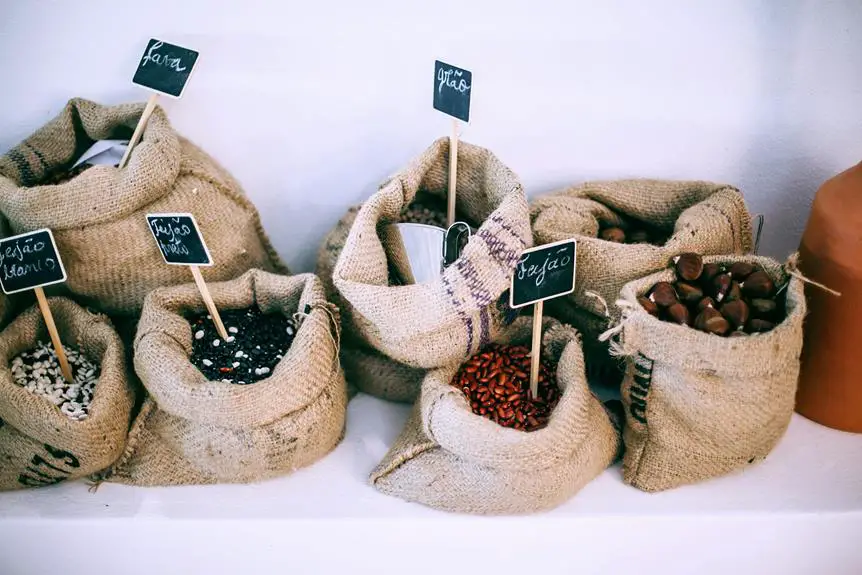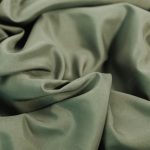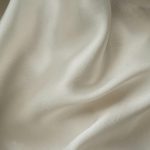When you're navigating the world of fabrics, understanding the differences between voile and crepe can significantly impact your fashion choices. Voile's lightweight, sheer nature makes it perfect for summer garments, while crepe's heavier, crinkled texture lends itself to structured styles. Each fabric has its own set of characteristics that cater to specific occasions, influencing not just aesthetics but also comfort. So, which fabric aligns better with your style goals? The answer might surprise you as you consider the unique qualities of both fabrics.
Table of Contents
Overview of Voile
Voile is a lightweight, sheer fabric often made from cotton or polyester, known for its soft drape and delicate appearance. When you touch it, you'll notice its smooth texture, making it a popular choice for garments like blouses, dresses, and skirts. The fabric's breathability allows you to stay cool in warmer weather, which is perfect if you enjoy wearing flowing, airy outfits.
You'll find that voile comes in various colors and prints, offering versatility in your wardrobe. Whether you're looking for something subtle or bold, there's a voile option that suits your style. Its sheer quality allows for layering, letting you create interesting looks by combining it with other fabrics.
Caring for voile is relatively easy, as it typically requires gentle washing and low heat drying to maintain its beauty. However, you might want to avoid high temperatures, as they can damage the fibers.
In home decor, voile works wonderfully for curtains, providing privacy while still allowing light to filter through. With its elegant charm and practicality, voile is an excellent choice for both fashion and interior design projects.
Overview of Crepe
Crepe is known for its unique texture and drape, making it a popular choice in fashion.
You'll often find it in dresses, blouses, and skirts due to its elegant appearance and versatility.
Understanding its characteristics and common uses can help you appreciate why it's favored by designers.
Characteristics of Crepe
Known for its unique texture and drape, crepe fabric offers a distinctive feel that sets it apart from other materials.
Its characteristic crinkled surface creates a beautiful flow, giving garments a soft, elegant look. You'll notice that crepe has a slight stretch, which enhances comfort and allows for better movement in clothing. This elasticity is due to the twisting of the yarns used in its production.
Crepe comes in various weights, from lightweight to heavier options, making it versatile for different types of apparel. The lightweight crepe is breathable and perfect for warm weather, while heavier crepe provides a more structured silhouette suitable for cooler climates.
Another notable feature is its ability to drape beautifully, allowing it to create soft, flattering lines on the body. Crepe resists wrinkling, so you won't have to worry about constant ironing, which makes it an excellent choice for busy lifestyles.
Additionally, it has a luxurious feel that adds a touch of sophistication to any outfit. With its unique characteristics, crepe fabric stands out as an option that blends comfort with style seamlessly.
Common Uses in Fashion
When it comes to fashion, crepe fabric shines in a variety of garments, from elegant dresses to chic blouses. Its unique texture and drape make it a favorite among designers and fashion enthusiasts alike. You'll often find crepe used in evening gowns, where its flowy nature enhances movement, giving a graceful silhouette. It's also popular for tailored pieces like suits and trousers, offering a sophisticated look without sacrificing comfort.
In casual wear, crepe tops and skirts provide an effortless yet polished appearance, making them versatile for both day and night. You might also see crepe used in activewear, as its breathable qualities and slight stretch allow for ease of movement.
Additionally, crepe is a go-to for layering pieces, such as cardigans and shawls, thanks to its lightweight feel.
Don't forget about crepe in accessories, too; scarves made from this fabric drape beautifully and add a touch of elegance to any outfit.
Key Characteristics of Voile
Voile is a lightweight, sheer fabric that offers a soft drape and a slightly crisp texture, making it perfect for airy garments and elegant overlays. You'll appreciate its versatility in various fashion applications, from dresses to curtains.
Here are some key characteristics that set voile apart:
- Breathability: Voile's open weave allows air to flow freely, keeping you cool and comfortable, especially in warm weather.
- Transparency: Its sheer quality lets you layer it creatively, achieving beautiful visual effects in your outfits or home decor.
- Softness: This fabric feels gentle against the skin, making it an excellent choice for delicate garments like blouses or skirts.
- Easy to Care For: Voile is generally machine washable and resistant to wrinkles, ensuring that your garments maintain their fresh look with minimal effort.
With these attributes, you'll find voile to be a delightful addition to your wardrobe or home. Its elegant appearance and practical qualities make it a favorite among designers and DIY enthusiasts alike.
Embrace the charm of voile and enjoy its myriad possibilities!
Key Characteristics of Crepe
Crepe is a uniquely textured fabric that stands out for its crinkled surface and fluid drape, making it ideal for a variety of stylish garments. One of the key characteristics of crepe is its distinctive texture, which can vary from fine to coarse, depending on the type of fibers used. This texture adds depth and interest to your outfits, enhancing their visual appeal.
You'll also appreciate crepe's excellent versatility. It can be made from natural fibers like silk, wool, or cotton, as well as synthetic options like polyester. This variety allows crepe to come in different weights and finishes, catering to different styles and preferences. Moreover, crepe tends to have a natural stretch, giving it a comfortable fit that moves with you.
Another important feature is its wrinkle-resistant nature. If you want a fabric that looks fresh throughout the day, crepe is a smart choice.
Common Uses for Voile
Many designers favor voile for its lightweight and airy quality, making it perfect for summer garments like dresses and blouses. This fabric not only drapes beautifully but also offers a soft texture that feels comfortable against your skin. You'll find voile commonly used in various applications, enhancing both fashion and home decor.
Here are some common uses for voile:
- Dresses: Voile is ideal for flowy summer dresses, providing breathability and movement.
- Blouses: You can create elegant blouses that are perfect for layering or wearing alone, especially in warm weather.
- Curtains: Many homeowners choose voile for sheer curtains, allowing natural light to filter in while maintaining privacy.
- Lining: Voile works well as a lightweight lining for garments, adding a touch of softness without adding bulk.
Incorporating voile into your wardrobe or home can elevate your style and comfort. Its versatility makes it a favorite choice for many projects, ensuring you'll find the perfect use for this delightful fabric.
Common Uses for Crepe
When you think about crepe, consider its versatility across different clothing styles.
You can find it in elegant evening wear, professional attire, and even casual garments.
Each use highlights crepe's unique drape and texture, making it a popular choice for various occasions.
Evening Wear Applications
You'll find that crepe is a popular choice for evening wear due to its elegant drape and lightweight feel. This fabric not only offers comfort but also exudes sophistication, making it perfect for various formal occasions.
When you choose crepe for your evening attire, you can expect to shine in styles that flatter your figure and keep you at ease throughout the event.
Here are some common evening wear applications for crepe:
- Cocktail Dresses: The flowing texture of crepe makes it ideal for stylish cocktail dresses that move gracefully with you.
- Evening Gowns: Opt for a floor-length crepe gown that hugs your curves beautifully while providing a chic silhouette.
- Formal Jumpsuits: Crepe jumpsuits combine modernity with elegance, offering a fresh alternative to traditional dresses.
- Dressy Tops and Skirts: Pair a crepe top with a sleek skirt for a polished look that's perfect for semi-formal gatherings.
With its versatility and luxurious appeal, crepe is a fabric that ensures you'll look stunning for any evening occasion.
Professional Attire Options
Crepe is an excellent choice for professional attire, offering a polished look that balances style and comfort in the workplace. You'll find it's versatile enough for various settings, from business meetings to formal office events. Its lightweight and draping qualities make crepe garments flattering and easy to wear throughout your busy day.
Consider a tailored crepe blazer paired with dress pants for a classic yet modern business look. This combination not only exudes professionalism but also ensures you feel comfortable as you move from one task to the next. A crepe sheath dress is another fantastic option, providing a streamlined silhouette that's perfect for interviews or presentations.
When accessorizing, you can keep it simple with elegant jewelry and a structured handbag, enhancing the overall sophistication of your outfit. Crepe's ability to resist wrinkling is a significant advantage, allowing you to maintain a crisp appearance, even after long hours at the office.
With its range of colors and patterns, crepe fabric can adapt to your personal style while still adhering to workplace dress codes. Choose crepe for your professional wardrobe, and you'll feel confident and stylish every day.
Casual Garment Uses
Many people enjoy wearing crepe for casual outings due to its comfortable feel and stylish appearance.
This fabric drapes beautifully, making it a favorite choice for various casual garments. You'll find that crepe is versatile and easy to style, allowing you to create numerous looks suitable for different occasions.
Here are some common uses for crepe:
- Dresses: Casual crepe dresses are perfect for brunch or a day out with friends. They provide a relaxed yet chic vibe.
- Tops: Crepe blouses or tees can be paired with jeans or shorts for a laid-back, fashionable look.
- Skirts: Flowing crepe skirts are ideal for a summer picnic or a casual stroll in the park, offering comfort without compromising style.
- Loungewear: Crepe is also great for cozy loungewear sets, combining softness with a polished appearance, perfect for lounging at home or running errands.
With its lightweight and breathable nature, crepe ensures you stay comfortable while enjoying your casual outings in style.
Embrace this fabric, and you'll elevate your everyday wardrobe effortlessly!
Choosing Between Voile and Crepe
When selecting between voile and crepe, consider how each fabric's unique characteristics align with your project needs.
Voile is lightweight and sheer, making it perfect for airy dresses, blouses, or curtains. If you're after a soft, flowing look, voile's delicate texture can create a romantic, feminine vibe. However, keep in mind that it can be somewhat transparent, so lining may be necessary for certain garments.
On the other hand, crepe has a slightly heavier weight and a crinkled texture that adds depth and structure to your designs. It drapes beautifully, making it an excellent choice for tailored clothing, like skirts and dresses that require more form. Crepe's durability means it holds up well in everyday wear, and it's less prone to wrinkling compared to voile.
Think about your desired outcome: if you want something light and airy, go with voile; if you need a more structured option that still offers movement, crepe might be your best bet.
Ultimately, your choice should reflect the style and function of the garment you're creating.
Frequently Asked Questions
Can Voile and Crepe Be Blended With Other Fabrics?
Yes, you can blend voile and crepe with other fabrics. Mixing them with cotton, silk, or polyester can enhance their texture and appearance, creating unique materials that suit various design needs and styles.
How Do I Care for Voile and Crepe Fabrics?
To care for voile and crepe fabrics, always check the label first. Generally, wash in cold water, use mild detergent, and air dry. Iron on low heat to maintain their delicate texture and prevent damage.
Are There Eco-Friendly Options for Voile and Crepe?
Yes, there are eco-friendly options for fabrics. Look for organic cotton, linen, or recycled polyester alternatives. These materials often reduce environmental impact while providing similar qualities, so you can make sustainable choices in your wardrobe.
What Are the Price Differences Between Voile and Crepe?
When considering price differences, you'll find voile often costs less than crepe. The variation depends on factors like quality and brand, so it's wise to compare prices before making your final decision.
How Do I Identify Genuine Voile or Crepe Fabrics?
To identify genuine voile or crepe fabrics, feel the texture; voile's lightweight and smooth, while crepe's slightly crinkled. Check the drape, too—voile flows gently, whereas crepe has a more structured, textured look.
- Jaclyn Smith Fabric Coconut: a Review of This Rayon/Polyester Blend - June 29, 2025
- Jaclyn Smith Fabric Coconut: a Review of This Rayon/Polyester Blend - June 29, 2025
- How to Get Coconut Oil off Fabric Without Washing - June 29, 2025







